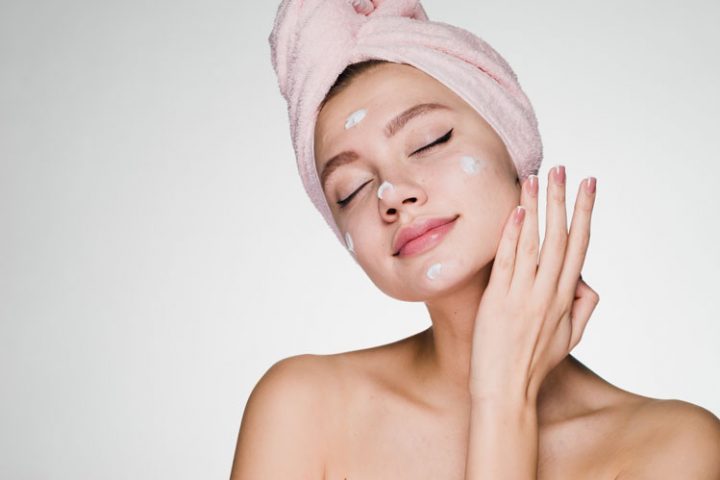
Vitamin A is considered to be the ultimate cosmeceutical for almost all skin types. Doctor Albert Kligman discovered the power of Vitamin A as an essential skin ingredient. He used Vitamin A in the form of Retinoic acid to regulate oil glands and cell turnover. However he also discovered that this molecule was able to reduce skin pigmentation and address fine lines.
As a result it has been used to address visible ageing for the last twenty years and is used to address over 125 skin disorders including acne, psoriasis, pigmentation and sun damage.
Over the years Vitamin A has evolved to become more stable and more specific in its action on the cells. Vitamin A for the skin is referred to as the family of ‘retinoids’. Within this family, there are a number of different compounds including:
- Tretinoin = all trans retinoic acid (doctor’s prescription required). The most potent form of Vitamin A
- Retinol (The most popular non-prescription form of Vitamin A. Converted to potent retinoic acid in the keratinocytes). Present in Synergie Skin Ultimate A serum.
- Retinaldehyde (intermediate form of Vitamin A)
- Retinyl palmitate (Ester form of Vitamin A. Considered ineffective and has been superseded by more effective forms )
When it comes to formulating the Synergie Skin products, I refer to my ‘SEED Principle’:
- Stability – The ingredient must not be prone to oxidation or breakdown
- Effectiveness – The ingredient must actually work and have data to support the benefits.
- Elegance –The ingredient must have that ‘feel good’ quality and the customer must want to use it. As well as touch and feel, the product must not have an unpleasant fragrance.
- Delivery – The cosmeceutical active ingredients must be able to reach its target cell to create the desired biological effects.
With that in mind, let’s consider Vitamin A through my SEED priniciple:
1) STABILITY
No matter how effective the ingredient is, it must not break down before it reaches its target cell. Although the medical retinoid Tretinoin (all trans retinoic acid) is highly effective, it is unstable and susceptible to oxidation. Traditional Retinol and Retinaldehyde is also highly unstable and easily oxidized rendering it inactive on the skin. Liposomally stabilised retinol and other new forms of vitamin A are able to deliver effective results without the unwanted side effects. Further, these new derivatives are often stable, so consumers are able to keep them in their bathroom cabinet without a short expiry date.
2) EFFICACY
Vitamin A is often referred to as the great ‘cellular regulator’ due to its ability to control cell growth and differentiation. Retinoids are extremely powerful as they are actually able to program our genes (DNA) in the nucleus of our cells to perform the following specific functions:
Regulation of cell turnover
In the nucleus of our cells there are receptors (RAR’s and RXR’s) that are specific to Vitamin A. When the retinoid binds to these receptors (mainly in the epidermis of the skin) the DNA is programmed to increase differentiation of keratinocytes, normalize the turnover of our skin cells It also reduces cell inflammation and cell over-production. Vitamin A also thickens and compacts the epidermis to give a more youthful appearance to skin.
Sun damage reversal
UV light increases the production of substances called MMP’s which break down our collagen. Vitamin A inhibits these MMP’s and as a result, helps to preserve healthy collagen.
Collagen stimulation
Vitamin A causes stimulation of fibroblasts, the cells that make collagen in the deeper skin layers (dermis), resulting in reduction of fine lines
Oil regulation for acne
One of the most effective topical treatments for overactive oil (sebaceous) glands is retinoids. Oils gland cells are overly active in acne sufferers. These cells have a receptor on their surface the binds to vitamin A and initiates a cascade of events that normalises the growth pattern of the cells (sebocytes). Retinoids cause oil glands to decrease in size and reduces their growth rate, resulting in dramatically decreased oil production
Pigmentation reduction
Vitamin A reduced the activity of tyrosinase, an enzyme critical for the production of melanin. Vitamin A also reduces the clumping of pigment (melanin) in the base of the epidermis and makes the actual pigment particles (melanosomes) smaller and less visible. Furthermore, because the cells are turning over in more orderly manner, the pigment trapped in the outer cells is also being removed efficiently.
3) ELEGANCE
The problem with prescription Tretinoin (retinoic acid) and even traditional retinol is that the molecule binds to undesired receptors not involved in the expected effects of vitamin A. these undesirable side effects include:
- Flaking (due to decreased ceramides)
- Irritation
- Redness
Consequently patients tend to discontinue use due to this lack of elegance in Tretinoin and traditional retinol. Doctors recommend gradually increasing tolerance over 3 months and not to mix with acids. Many patients do not comply with this suggested regimen.
Thankfully, there are many new forms of Vitamin A currently on the market that are available without prescription. The effective ingredients are still converted to retinoic acid in the skin cells but are less irritating as they make their way to the target cells.
4) DELIVERY
Retinol is highly effective and penetrative provided it is not oxidized. It offers enhanced penetration and stability versus traditional retinol. When retinol penetrates the cell it is converted to retinoic acid in the cells. It then combines with receptors in the nucleus where it exerts its biological effects without irritation.
Vitamin A truly has evolved into a more stable, elegant and improved delivery system with minimal risk of irritation to the user. Rovisome ticks all the boxes and certainly adheres to my SEED principle compared to other forms of Vitamin A currently available.
